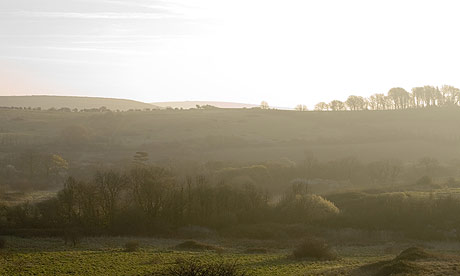
Several acres of Two Mile wood outside Weymouth are under threat from plans to build a bypass. This remnant of ancient forest is known for its association with the writer Thomas Hardy. Photograph: Woodland Trust
Ancient woodland in Britain is being felled at a rate even faster than the Amazon rainforest, according to new research today. It shows that almost half of all woods in the UK that are more than 400 years old have been lost in the past 80 years and more than 600 ancient woods are now threatened by new roads, electricity pylons, housing, and airport expansion.
The report from the Woodland Trust comes as the government prepares to sign a compulsory purchase order to buy several acres of Two Mile Wood outside Weymouth to build a bypass. This remnant of ancient forest, known for its association with Thomas Hardy, is one of Britain's finest bluebell woods and is full of old beech, oak and hornbeam trees.
"Ancient woodland, designated as over 400 years old in England, is the UK's equivalent of rainforest. It is irreplaceable," said Ed Pomfret, campaigns director of the trust. "It's our most valuable space for wildlife, and home to rare and threatened species. Once these woods have gone, they will never come back. They are historical treasure troves."
Species such as the willow tit, marsh tit, barbastelle bat, Bechstein's bat, pearl-bordered fritillary butterfly and dormouse all rely on ancient woodland to survive.
The rate at which the UK has lost ancient woodland is one of the fastest in the world and compares unfavourably with the Amazon. Studies suggest that the Amazon has lost 15% of its area in the past 30 years and perhaps just 2% before that in the previous several thousand years.
Pomfret appealed to government for better protection of the remaining woods. "If these woods were buildings they would be protected to the highest grading. But natural heritage is not afforded the same importance, despite the fact many ancient woodland sites date back far beyond that of the built environment," he said.
Many of the woods are designated for their scientific and conservation importance but this does not guarantee protection. Nearly 85% of ancient woodland, including five of the 12 largest woods in England, has no designation at all. For those that are protected, "loopholes in the planning system allow this protection to be overridden if a developer can prove an economic need," said Pomfret.
The report says that in the last decade 100 square miles (26,000 hectares) of ancient woodland in the UK has come under threat, equivalent to an area the size of Birmingham. But pressure on the habitat is now growing said Pomfret.
Overall, only 1,193 square miles (308,000 hectares) of ancient woodland survive in Britain. Few are larger than 50 acres and only 14 woods are larger than 740 acres. Most have been continuously managed by humans for hundreds if not thousands of years.
Nearly half of the threatened woods are in the south-east, with more than 30 in East Sussex. There are 243 are threatened by road schemes, 216 by power lines, 106 by housing, 61 by quarrying and 45 by airport expansion.
The trust believes there could be many more ancient woods under threat than their research suggests, and is appealing to the public to help identify them. "We can't rely on any official body to help us. We need eyes and ears for woodland to help stop ancient woodland destruction on our doorsteps," said Pomfret.
"The pressure on these very valuable woods is great, but there are major restoration programmes taking place. We are encouraging the Forestry Commission and private owners to protect them, but we are aware that planning authorities still take other things into account when deciding on developments," said Keith Kirby, chief forestry officer at Natural England, the government conservation advisers.
The threats posed to the UK's ancient woodland
Aberdeen Western Bypass: Fifteen ancient woods at risk of damage by a new dual carriageway around Aberdeen. Currently at public inquiry stage.
Weymouth relief road: Two Mile Coppice ancient woodland would be partly destroyed by this road expansion linking Weymouth to Dorchester. The Woodland Trust, and other bodies, fought this case at public inquiry.
Lake Wood, Uckfield, East Sussex: Lake Wood is threatened by local council application for 750 houses. The planning application was rejected, the developers appealed and the result of a public inquiry is expected shortly.
Bramley Frith Wood, Hampshire: The National Grid wanted to expand its existing electricity sub-station into this wood, which is hugely valuable for wildlife and used to have an education centre where nationally important research on dormice was undertaken. The Woodland Trust opposed this and even took the government's biodiversity advisers to court to try to overturn the decision but National Grid is now pressing ahead.
Stansted airport, Essex: BAA is planning a new runway which would destroy five ancient woods and damage many more. They have submitted a planning application and the case will be considered at a public inquiry next year.
Horton wood, West Sussex: Threatened by a landfill site which wants to expand. The planning application is being decided without an environmental impact assessment.



No comments:
Post a Comment